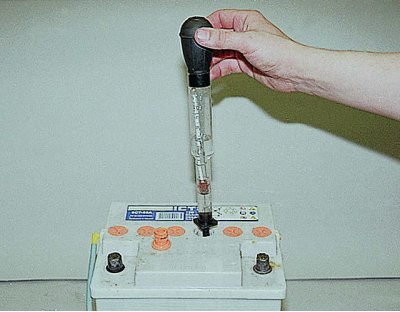The battery consists of six series-connected batteries placed in separate compartments of a common body (positive and negative lead plates are separated by separators). The compartments are filled with an electrolyte - a solution of sulfuric acid in distilled water, with a density of 1.27–1.28 g/cm3.
Technical specifications
| Rated voltage, V | 12 |
| Capacity at 20-hour discharge and electrolyte temperature 25°C, A.h | 55 |
| Electrolyte volume, l | 3,6 |
| Charge current, A | 5,5 |

The battery case is made of translucent plastic with markings on the permissible electrolyte level.
Maintenance of the battery consists of checking the level and density of the electrolyte. If the electrolyte level is poorly visible, we orient ourselves along the lower edge of the filler hole.

Density is measured with a hydrometer. After adding water, keep in mind that until the water is completely mixed with the electrolyte, the hydrometer readings will be underestimated.
The degree of charge of the battery can be indirectly determined by the voltage at its terminals (see table).
Battery voltage, V | Degree of charge, % |
12,6 | 100 |
12,0 | 75 |
11,6 | 50 |
11,3 | 25 |
10,5 | 0 |
We wipe the outer surfaces of the battery with a rag moistened with a solution of baking soda.
When working with the battery, strictly follow the safety regulations. Systematically check the reliability of the fastening of the terminals on the battery terminals.
